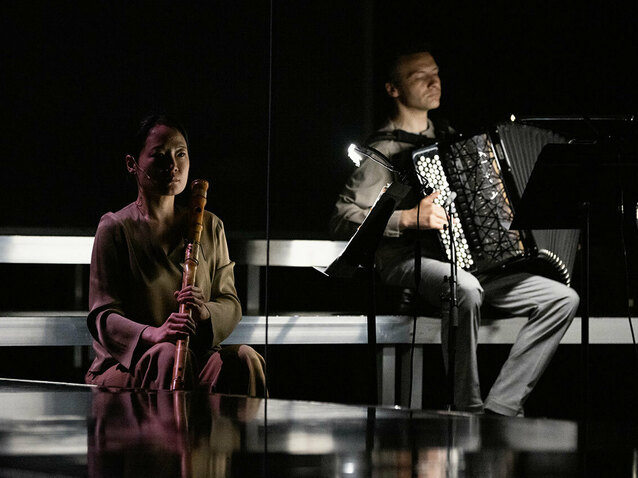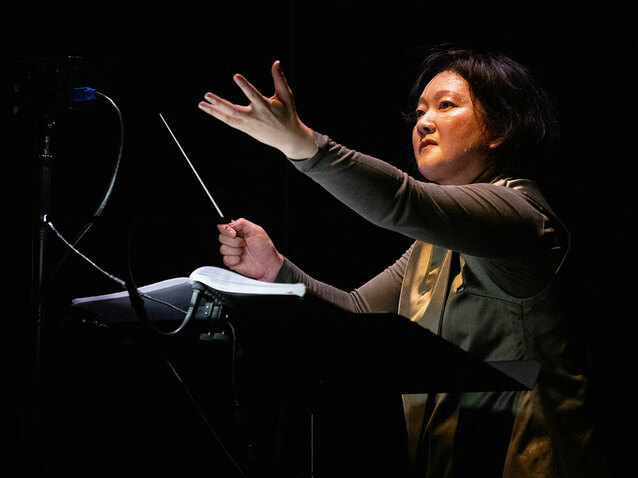 © Camilla Greenwell
© Camilla Greenwell
Bushra El-Turk’s Woman at Point Zero, with a libretto by Stacy Hardy, is based on Nawal El Saadawi’s 1975 novel Point Zero. Having already appeared in France (at the Aix-en-Provence Festival), Belgium and Luxembourg, it now comes to the Royal Opera House to take centre-stage at this year’s Engender Festival, an initiative to transform gender representation in opera and music theatre. The production is by LOD Music Theatre, and it is co-presented as part of the Aldeburgh Festival and Shubbak Festival 2023.
Set in Egypt, the story sees filmmaker Sama (an engaging Carla Nahadi Babelegoto) visit Fatma (a highly persuasive Dima Orsho) in prison. Sama is making a film about violence against women, and wishes to interview Fatma who has been imprisoned for murdering a man. Fatma questions Sama’s motives and initially refuses to talk, but she does eventually open up. Recalling a brutal, impoverished and sexually abusive childhood, Fatma describes how her life has always seen her caged by men who have simply behaved as they please towards her.
She ended up becoming a sex worker, first working for others but then independently in a move that made her feel for the first time that she was free. She was, however, harassed by a violent pimp who she murdered after he forced himself into her home. The courts threw the book at her as she made no attempt to mount a defence, and, while Sama begs her to appeal, Fatma refuses claiming that everyone is imprisoned only most people do not realise it. She urges Sama to make something beautiful from her story by judging it on its own terms, rather than on Sama’s preconceived ideas of what she was hoping to find or prove.

Woman at Point Zero © ROH Camilla Greenwell
Although the opera does much to expose the violence and sexual abuse that so many women are subjected to, its primary objective is not to judge whether or not Fatma was justified in murdering the man. Rather its aim is to allow these two women to be understood, and their voices heard, on their own terms. In this way, the story becomes just as much about Sama, as her own history and motivations for making the film come under the spotlight. It certainly emerges that there are similarities between Fatma and her own experiences, although initially Sama’s may not appear to be as extreme. However, by the time we have heard how she suffered sexual abuse during the Tahrir Square protests we realise that is not necessarily the case, and how every individual has their own experiences and reactions to them.
This point is made even clearer through the use of other voices. In origin, surtitles were designed simply to provide a translation for people who did not understand the language in which the piece was being performed. Here, they become a more integral part of the drama as Fatma and Sama’s lines are highlighted in two different colours, with the audio fragments of women who remain imprisoned that we hear being presented in a third. These fragments are inserted at points at which they add another dimension to what has just been uttered on stage. For example, when Fatma describes how when she was eighteen she was forcibly married to a man in his sixties, we hear of another woman’s experience where the specific ages are slightly different but the gap between them is commensurate. These additional perspectives reveal how the experiences of the women we see are those of so many others, and yet this is never suggested in such a way that we cease to see each individual as real and unique.

Kanako Abe (Conductor) - ROH Woman at Point Zero © Camilla Greenwell
In the Royal Opera House’s intimate Linbury Theatre, Laila Soliman’s staging may initially appear to be very simple, but it is highly intelligent as the orchestra comprising Ensemble ZAR becomes an integral part of the drama. All of the players occupy the stage, and the feeling that each of them is also a unique individual is emphasised by the fact that the instruments they play come from a wide variety of countries and cultures. Conducted by Kanako Abe, they play instruments as diverse as the Persian kamanche, Japanese shō and Korean taegŭm alongside the cello and accordion, but also do so much more. There are times when they shout words, such as the abusive terms Fatma was so used to hearing, or rise to mirror the actions that she carries out.
The music itself combines a variety of influences, with Arabic ones being particularly prevalent, and there are some wonderful ‘interludes’ that see just a few instruments take centre-stage. If there is a criticism it is that the opera seems just a little too intent on remaining measured and understated. As a result, while the story does have a beginning, middle and end, the music does not always help to highlight these different stages by, for example, really heightening the emotions at moments of climax or revelation. Nevertheless, it remains both skilful and compelling, and when superb performances combine with such important subject matter and effective video designs, courtesy of Bissane Al Charif and Julia König, the results are extremely worthwhile.
By Sam Smith
Woman at Point Zero | 28 - 30 June 2023 | Linbury Theatre, Royal Opera House, Covent Garden
the 01 of July, 2023 | Print
Comments